Criminal justice social work statistics in Scotland: 2015-2016
National-level information on criminal justice social work activity in Scotland, including data on criminal justice social work services and social work orders.
This document is part of a collection
5.2 Community payback orders
( Tables 2 & 9-23, Charts 3-7 and Infographic)
5.2.1 Community payback orders ( CPOs) were introduced in early 2011 to replace community service, probation and supervised attendance orders for offences committed from 1 February 2011 onward. They can include one or more of the following requirements:
- offender supervision
- compensation
- unpaid work or other activity
- programme
- residence
- mental health treatment
- drug treatment
- alcohol treatment
- conduct
If an individual fails to comply with the requirements in the order, a restricted movement requirement can also be imposed.
5.2.2 A total of 19,400 community payback orders commenced in 2015-16 ( Table 2), up by 2 per cent on 2014-15. This total has risen each year since the introduction of CPOs as the legacy orders are phased out though, as expected, the rate of this rise has levelled out.
5.2.3 People aged 18 to 25 were the most likely to be given a CPO when the population base was taken into account ( Chart 3). However, between 2013-14 and 2015-16, the prevalence fell for the 25 and unders, while increasing for the 26-40 age group. This is reflected in the fact that the proportion of CPO commencements covering those aged 25 and under has fallen each year, from 43 per cent in 2011-12 to 35 per cent in 2015-16 ( Table 9). The fall in the prevalence for under 18s continued the drop witnessed in recent years, in part due to the marked fall in court volumes for this age group.
5.2.4 Fifty-nine per cent of cases in 2015-16 involved individuals who were unemployed ( Table 9). Just over a fifth were employed or self-employed, and 10 per cent were not economically active.
5.2.5 The vast majority (94 per cent) of community payback orders were issued by sheriff courts, mainly by summary procedure. The proportion accounted for by justice of the peace courts has risen each year and these now account for almost 4 per cent of all CPOs issued ( Table 10).
Chart 3 Community payback orders commenced per 10,000
population by age and gender: 2013-14 & 2015-16
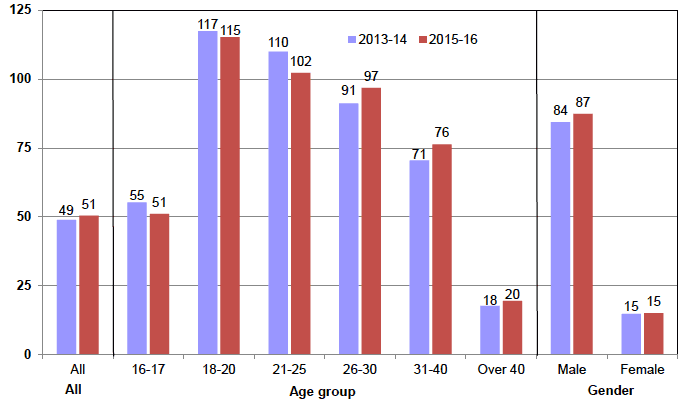
5.2.6 There were a total of 18,200 CPOs in force at 31 March 2016 (see Table 2 and the additional datasets which accompany this publication). There is not a long enough time series at present to allow meaningful comparison of snapshot numbers due to the gradual phasing out of legacy orders over the past few years.
Requirements
5.2.7 Seventy-eight per cent of community payback orders included a requirement for unpaid work or other activity, and just over half included supervision ( Table 11 and Chart 4). About half of the unpaid work requirements issued (53 per cent) were level 1 (100 hours or less) ( Table 12). Over half (56 per cent) of supervision requirements were for 12 months or less, while a further 40 per cent were for over 12 and up to 24 months ( Table 13).
Chart 4 Community payback order requirements: 2011-12 &
2015-16
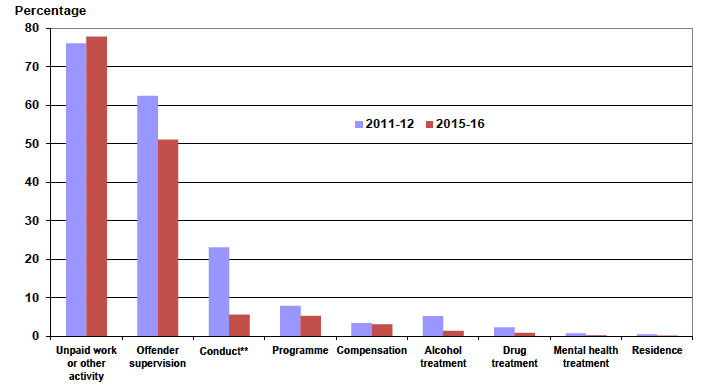
** The large reduction between 2011-12 and 2015-16 for conduct requirements reflects the 2012 appeal court judgement that conduct requirements must be specific (see §5.2.10).
5.2.8 Chart 5 illustrates that people who received long supervision requirements were very different in age terms than those who got shorter ones. For people given supervision of up to 6 months, 62 per cent were aged 30 or under, compared with only 38 per cent for those given the maximum of 36 months supervision. As a result, people given supervision of up to 6 months were, on average, more than 8 years younger than those given 36 months.
Chart 5 Offender supervision requirements imposed:
Breakdown by age group for shortest and longest supervision
lengths: 2015-16
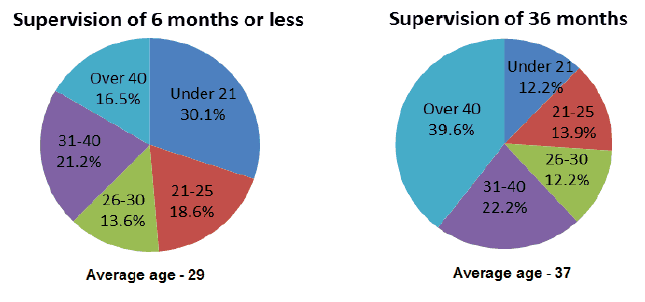
5.2.9 The average number of requirements issued has fallen each year since the CPO was implemented in 2011-12, although the scale of this fall has stabilised in the last couple of years. The average has fallen from 1.82 in 2011-12 to 1.45 in 2015-16. The use of all requirements has fallen between 2011-12 and 2015-16, apart from unpaid work or other activity ( Chart 4). Between 2014-15 and 2015-16, all requirements decreased in prevalence apart from offender supervision and compensation.
5.2.10 Part of the overall fall in the use of requirements can be explained by the sharp drop in the use of conduct requirements between 2011-12 and 2013-14, reflecting the 2012 appeal court judgement [1] that conduct requirements must be specific and include more than general conditions to stay out of trouble or to refrain from committing another criminal offence. Recent years' figures do however show that this fall appears to have stabilised ( Table 11).
5.2.11 Other requirements included programme (5 per cent) and compensation (3 per cent). Treatment for alcohol, drug and mental health problems accounted for relatively few requirements, ranging from 1.4 per cent ( alcohol) to less than a quarter of one per cent ( mental health).
5.2.12 Sixty-four per cent of community payback orders commenced in 2015-16 included one requirement - normally unpaid work/other activity or supervision. A further 28 per cent had two requirements (normally including supervision) ( Chart 6)
Chart 6 Community payback orders commenced by number of
requirements: 2015-16
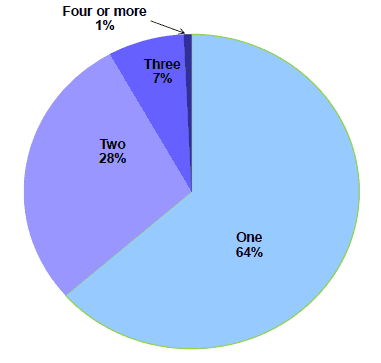
5.2.13 On imposing a community payback order, a court may include provision for the order to be reviewed at specified time(s). Seventeen per cent of orders commenced in 2015-16 were issued with provision for court progress reviews ( Table 14). This varied substantially according to the makeup of the order. Orders with unpaid work or other activity (14 per cent) or compensation (18 per cent) were the least likely to have progress reviews while those with residence, drug treatment or conduct were the most likely (50, 38 and 36 per cent respectively).
Community Payback Orders in Scotland: 2015-2016
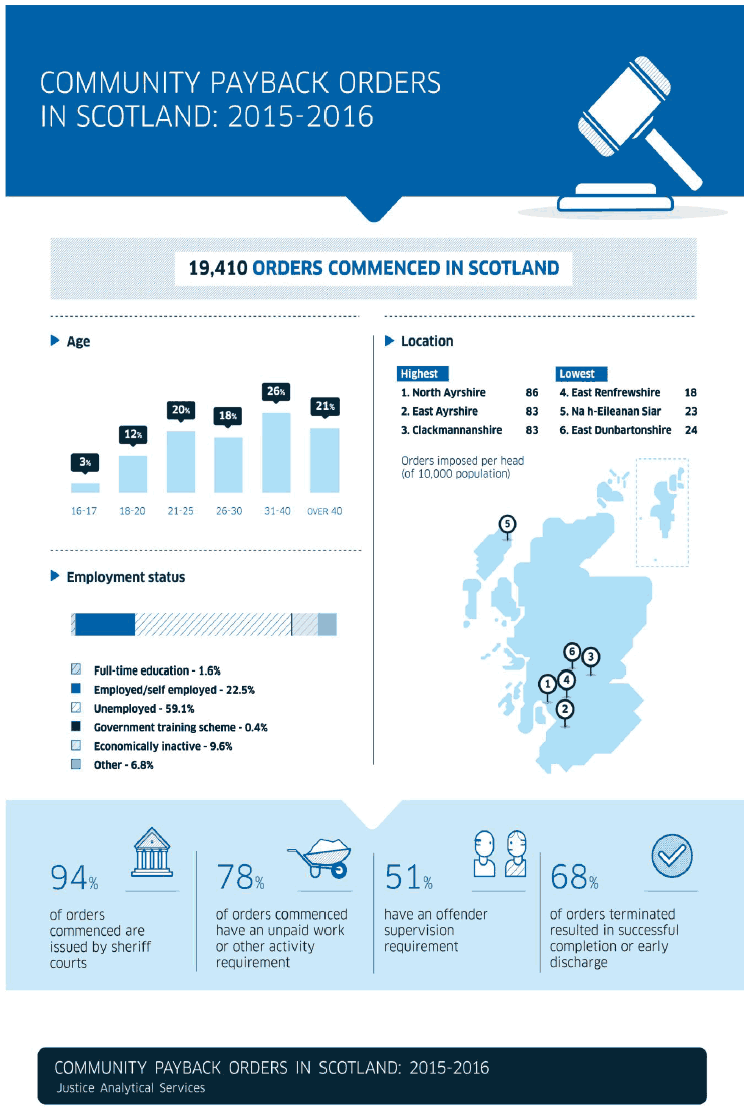
Timescales for implementation
5.2.14 The Scottish Government Community payback orders practice guidance is intended to support practitioners and managers to improve their performance and work towards the achievement of the national outcomes and standards for social work services in the criminal justice system. The guidance contains a number of principles of best practice, including:
- the first direct contact should take place on the same day as the order is imposed, or the next working day
- where a supervision requirement has been imposed, the appointed case manager should arrange to meet the individual within five working days of the date of imposition of the order
- where an unpaid work or other activity requirement has been imposed, arrangements should be made for the individual to begin the induction process within 5 working days of the date of imposition of the order
- where an unpaid work or other activity requirement is imposed, the work placement should begin within 7 working days of imposition of the order.
5.2.15 In over three-quarters of applicable cases (77 per cent) in 2015-16, first direct contact took place within one working day of the order being imposed ( Table 15). This proportion has remained at similar levels (between 75 and 80 per cent) over the last five years. The proportion which took over five working days (14 per cent) was the highest in the last five years.
5.2.16 The first induction / case management meeting took place within five working days in 79 per cent of applicable cases in 2015-16. Although this was the lowest in any of the last five years, trends have been relatively stable over this period. The proportion which took over ten working days (11 per cent) was the highest in the last five years.
5.2.17 There may be various reasons why these timescales are not met. Thirty-six per cent of delays in first direct contact were due to missed appointments, while the unavailability of a social worker (3 per cent) or other non client-related reason (30 per cent) together accounted for a further 34 per cent. Other client-based reasons included being subject to another sentence, employment or illness. Delays for the first induction / case management meeting were due to a wide range of reasons. In 15 per cent of cases the individual missed their induction/meeting, while a further 24 per cent involved being subject to another sentence, employment or illness. Another 12 per cent were due to delays in first making contact or staff availability, and 30 per cent of cases involved other client-based reasons ( Table 16).
5.2.18 In 2015-16, 68 per cent of applicable cases commenced work placements within seven working days ( Table 17). This was the lowest proportion over the past five years and the first time it has fallen below 70 per cent. The proportion which took over two months to commence (7 per cent) was the highest in the last five years. Just over a fifth of people who started their work placement after the seven working days did so because they did not turn up for the first day of placement ( Table 18).
Terminations
5.2.19 A total of 18,300 community payback orders were terminated in 2015-16 ( Table 19). Sixty-eight per cent (12,400) of these orders were successfully completed or resulted in an early discharge. The successful completion rate has fluctuated either side of 70 per cent each year since the orders were introduced. In 2015-16, a further 17 per cent were revoked following a breach application to the courts, 7 per cent were revoked following a review and the remaining 7 per cent were terminated for other reasons (including transfer to another area or the death of the person).
5.2.20 Almost three-quarters of orders terminated during 2015-16 did not involve any breach applications during the lifetime of the order ( Table 20). For the remainder, there were a total of 5,700 breach applications made ( Table 21). The vast majority of breach applications (83 per cent) were lodged with the court within five working days of the decision to make an application.
5.2.21 For CPOs revoked due to breach, the most likely outcome was a custodial sentence (30 per cent) followed by a new order being imposed or another outcome (28 and 23 per cent respectively) ( Table 19). Fifteen per cent of orders revoked due to review resulted in a custodial sentence, while around half resulted in another outcome.
Chart 7 Completions/discharges of community payback orders
by gender, age, employment status and number of requirements:
2015-16
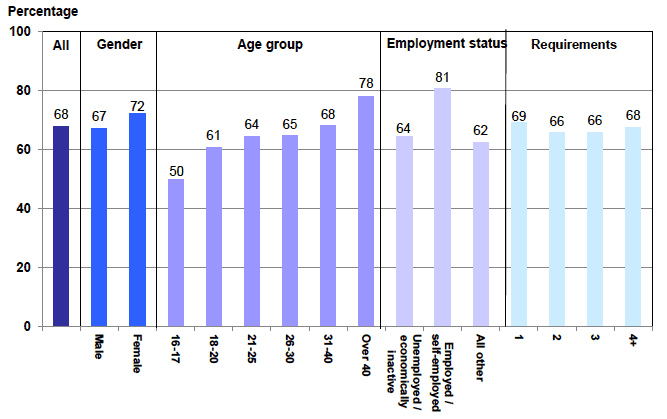
5.2.22 Completion rates in 2015-16 varied substantially by age and employment status ( Chart 7). They showed a consistent increase with age, ranging from 50 per cent for 16-17 year olds to 78 per cent for the over 40s. Eighty-one per cent of those who were employed or self-employed completed successfully, compared to 64 per cent of those who were unemployed or economically inactive. Completion rates did, however, vary little according to how many requirements were in the order.
5.2.23 During 2015-16, a total of 9,500 unpaid work or other activity requirements were successfully completed ( Table 22). On average, just over 120 hours were carried out for each order and they took just over 6½ months to complete.
5.2.24 The Criminal Justice and Licensing (Scotland) Act 2010 defines the time limit for completion of an unpaid work or other activity requirement as "3 months or such longer period as the court may specify in the requirement" for level 1 and "6 months or such longer period as the court may specify in the requirement" for level 2. Just under 40 per cent of successfully completed unpaid work activity requirements were completed within the 3/6 month time frame while a further 30 per cent were completed within a longer timescale which the court had specified ( Table 23).
5.2.25 For the remaining requirements which were completed outwith the specified timescale, the reason why they were completed later was most commonly down to non-compliance (20 per cent) or other client-based reasons (40 per cent). In a further 24 per cent of cases this was attributed to the person's employment commitments or their health.
Contact
There is a problem
Thanks for your feedback